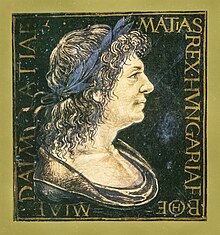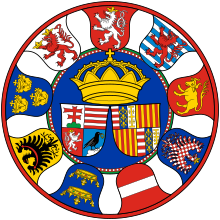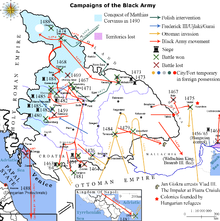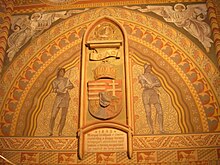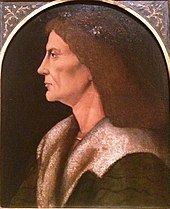Matthias Corvinus
Matthias Corvinus , actually Hunyadi ( Hungarian Hunyadi Mátyás , Romanian Matei Corvin , Croatian and Serbian Matija Korvin , Slovak Matej Korvín , Czech Matyáš Korvín , Slovenian Kralj Matjaž for "King Matthias"; * February 23, 1443 in Klausenburg , Transylvania ; † 6. April 1490 in Vienna ) was, from 1458 to 1490 King of Hungary and in personal union also of Croatia 1469 to 1490 (counter) King of Bohemia and the conqueror large parts of the Habsburg hereditary lands until 1490 he dominated in 1485 from Vienna .
Surname
The name Corvinus comes from the Latin corvus , 'the raven' - a scholar working at his court traced the origin of the family back to the Roman noble family of Corvini, whereupon the family coat of arms with the raven was created. There are other references to the raven: The Hunyadi family estate included the raven rock. According to a legend, Matthias was robbed of his ring by a raven during a hunt, which he shot down with his presence of mind and thus regained his ring. Another legend tells that when he was hostage in Prague, his mother sent him messages through a raven.
Life
Matthias was the younger of the two sons of Johann Hunyadi and Erzsébet (Elisabeth) Szilágyi von Horogszeg. The father distinguished himself as a fighter against the Turks , whom he defeated in several major battles, including in 1456 at Nándorfehérvár - today Belgrade - which he successfully horrified . During the minority of King Ladislaus Postumus , Johann Hunyadi was imperial administrator . After the execution of his older brother László (Ladislaus) in 1457, Matthias was elected King of Hungary on January 24, 1458 to succeed his father at the age of fourteen. He was supported by the Bohemian King George of Podebrady , who had previously captured him (1456/57). He made himself Friedrich III. to the enemy, who also claimed the Hungarian royal crown and was able to rely above all on the nobility of western Hungary, who mostly rejected a Hunyadi kingship. On July 19, 1463 a provisional settlement ( Peace of Ödenburg ) was concluded, which brought some western Hungarian areas ( similar to today's Burgenland ) to Austria. There they remained formally until 1622. Matthias bought back the St. Stephen's Crown for 80,000 gold forints and was crowned on March 29, 1464 in Stuhlweissenburg .
In 1469, with the blessing of the Pope and his armed forces - given because of the lack of recatholization of Bohemia after the Hussite Wars - he moved to Moravia to overthrow his father-in-law Georg von Podebrady, whose daughter Katharina he had married in 1461, as the Bohemian king. At the request of the Grünberger Alliance , he had himself elected as the opposing king in Olomouc in 1469 in order to create the opportunity to be elected German Emperor. He recognized early on that he could only successfully withstand the growing threat from the Turks with the help and resources of the West. Pope Paul II , who wanted to strengthen his fight against the Turks and the Bohemian heretics, consecrated the sword and hat insignia made for Corvinus in 1470 . A courier with a papal certificate delivered the decoration in April 1471.
The sudden death of Georg von Podiebrad in 1471 came to his aid. But Matthias could never conquer the real Bohemia; his rule extended only over the Bohemian neighboring countries Moravia , Silesia (with Breslau ), Upper and Lower Lusatia . Nevertheless, he called himself King of Bohemia from 1469 and was crowned in 1471. The coronation ceremony was attended by the papal legate Lorenzo Roverella , the Olomouc Bishop Tas Protasius von Boskowitz and Černahora and the provost of Vyšehrad , Johann von Rabstein , who had already supported the Hungarian monarch in the fight against Georg von Podiebrad. The struggle for the throne ended with the Peace of Olomouc in 1479 , in which the Kingdom of Bohemia was temporarily divided between two rulers, Vladislav II Jagellonský and Matthias Corvinus. In Bohemia itself, Vladislav II, who was elected by the estates there and who was later to succeed Mathias Corvinus in Hungary, asserted himself.
In 1462, Vlad III. Drăculea (called Romanian Țepeș , German the impaler ) on his flight from the Turks protection with Matthias Corvinus, who was now King of Hungary. However, he had Vlad thrown into dungeon (partly also at Hunedoara Castle ); only when Corvinus' relative Ilona Szilágyi fell in love with Vlad, was he partially pardoned. In 1471 Matthias founded the Serbian Despotate in southern Hungary to better protect the borders .
After various victories against the Turks, the Hungarian territory under Matthias Corvinus reached its greatest extent. It stretched from Lausitz to today's Bulgaria .
On December 22nd, 1476 he married Beatrix of Aragón for the second time . The arguments with Friedrich III. continued, although they were repeatedly interrupted by various armistices and peace treaties. After there was another war between Matthias Corvinus and Friedrich III in 1482. came, the Hungarian troops occupied large parts of the Habsburg hereditary lands. To this end, King Matthias had raised three armies. The army led by István Dávidházy († 1484) besieged Bruck an der Leitha , the army commanded by Tobias von Boskowitz and Černahora set out to conquer other places in Lower Austria and to secure the troops besieging Bruck, and the third army, the was led by Péter Geréb , marched into Styria and Carinthia, to the armed forces of Frederick III. to tie.
After Bruck and his citadel had fallen, the Hungarians began the siege of Korneuburg in April 1484 , which also served the purpose of cutting through Vienna . Friedrich III. wanted absolutely to prevent the loss of Korneuburg. He sent a field army to relieve the city, but they suffered a defeat in the battle of Leitzersdorf . With the outcome of the battle, not only the fate of Korneuburg but also that of Vienna was sealed. On June 1, 1485, after a siege that lasted around four months, King Matthias entered the city as victor, where he often resided until the end of his life. In the same year Corvinus was able to win large parts of Styria . He died unexpectedly in 1490, whereupon Austria was regained by Friedrich. Hungary and Bohemia remained united after the Treaty of Olomouc of 1479 and fell to King Vladislav II of the Jagiellonian family . Other applicants for the crown were Johann II von Sagan , Maximilian von Habsburg, the Polish Prince Johann Albrecht and the king's widow Beatrix. Matthias left only the illegitimate son Johann Corvinus . This was passed over in the succession to the throne.
The black army
Deviating from the previous practice, Matthias Corvinus kept a mercenary army in addition to the usual aristocratic army . The first such army was formed in France in 1445. Corvinus' so-called Black Army (Fekete Sereg) was recruited between 1459 and 1460, consisted of around 8,000 to 10,000 soldiers and was the basis of his power. It was composed mainly of non-Hungarian soldiers. In the course of time, several famous military leaders, such as Balázs Magyar , István Báthory , or the Wallachian prince Vlad Țepeș , the Serbs Jakšić and Branković, the Turkish heir to the throne Bajezid Callixtus Ottomanus and the Hungarian nobleman Pál Kinizsi were at their head . It was also he who smashed the pillaging remnants of the Black Army after Corvinus' death in 1494. After the king's death, the troops had received no more pay and tried to keep the rural population harmless.
Cultural policy
In terms of cultural history, Matthias Corvinus' reign is particularly significant due to his reception of the Italian Renaissance and Renaissance humanism . His tutor, Johann Vitez, was already influenced by this new intellectual trend. His marriage to his second wife, the Neapolitan princess Beatrix of Aragón, in 1476 in the Matthias Church finally acted as a catalyst . Buda and Vienna benefited greatly from the Renaissance artists whom he brought to his court and the close relationships he maintained with Florence and Lorenzo il Magnifico from the Medici family.
His Bibliotheca Corviniana in the 1480s was one of the largest collections of scientific and philosophical writings of that time. It comprised around 5000 volumes, some of which cost more than 1000 gold ducats, including the so-called Corvines . Corvinus made a major contribution to bringing the culture of the Renaissance and its worldview to the north of the Alps. At his request, the Universitas Istropolitana was founded in Pressburg ( Bratislava ) in 1465 , but it was closed again in 1490.
Aftermath

At the Matthias Tower in Bautzen, named after Corvinus, there is an oversized stone relief depicting the Hungarian king. Copies can be found in Budapest and Szeged , among others . Corvinus University in Budapest is named after him.
Corvinus has often been ascribed the authorship of the ridiculous verse Bella gerant alii, tu felix Austria nube , which alludes to the Habsburgs 'marriage policy (which was particularly successful under Corvinus' opponent Friedrich von Habsburg) . However, the first evidence of the verse is not found until the 17th century.
There are numerous legends about Matthias Corvinus . He is said to have often moved incognito and disguised himself as a beggar or student, among other things, in order to learn more about the worries and concerns of the people. He is said to have used this information later as the judge for a fair assessment. In Hungary he is still called Mátyás, az igazságos ("Matthias, the Righteous"). According to a Slovenian legend, King Matthias ( Kralj Matjaž ) waits in the interior of the Petzen mountain , in the border area between Carinthia and Slovenia, with his followers for a world battle (so-called mountain rapture ).
literature
- Christian host, Ekaterini Mitsiou, Ioan Aurel Pop, Mihailo Popović, Johannes Preiser-Kapeller, Alexandru Simon (eds.): Matthias Corvinus und seine Zeit. Europe at the transition from the Middle Ages to the modern age between Vienna and Constantinople (= publications on Byzantium research. Vol. 27). Publishing house of the Austrian Academy of Sciences, Vienna 2011, ISBN 978-3-7001-6891-1
- Péter Farbaky; Louis Alexander Waldman (ed.): Italy and Hungary. Humanism and art in the early Renaissance . Florence 2011.
- Péter Farbaky (ed.): Matthias Corvinus, the King. Tradition and renewal in the Hungarian Royal Court 1458 - 1490. Exhibition catalog Budapest History Museum 19 March 2008 - 30 June 2008 . Budapest 2008.
- Attila Bárány, Attila Györkös (eds.): Matthias and his legacy. Cultural and political encounters between East and West (= Speculum historiae Debreceniense. Vol. 1). University of Debrecen, Department of History, Debrecen 2009, ISBN 978-963-473-276-1 .
- Ernst Gamillscheg , Otto Mazal , Brigitte Mersich: Matthias Corvinus and the formation of the Renaissance . Exhibition catalog of the Austrian National Library, Vienna 1994. ( Table of contents PDF; 202 kB).
- Matthias Corvinus and the Renaissance in Hungary 1458–1541. Exhibition catalog Schallaburg '82 . Vienna 1982.
- Andras Kubinyi: Matthias Corvinus. The government of a kingdom in East Central Europe 1458–1490 (= Studies on the History of Hungary. Vol. 2). Herne 1999, ISBN 3-933337-13-5 .
- Jörg K. Hoensch : Matthias Corvinus. Diplomat, general and patron. Graz-Vienna-Cologne 1998, ISBN 3-222-12640-2 .
- Karl Nehring: Matthias Corvinus, Emperor Friedrich III. and the empire. To the Habsburg-Habsburg contrast in the Danube region. Munich 1975, ISBN 3-486-47951-2 .
- Karl Nehring: Matthias I. Corvinus. In: New German Biography (NDB). Volume 16, Duncker & Humblot, Berlin 1990, ISBN 3-428-00197-4 , pp. 407-409 ( digitized version ).
- Gyula Rázsó: The campaigns of King Matthias Corvinus in Lower Austria 1477–1490 (= military historical series. Issue 24). 3. Edition. Österreichischer Bundesverlag, Vienna 1982, ISBN 3-215-01666-4 .
- Adrian Kovács: Mathias Corvinus - The colorful life path of the penultimate knight, Vienna 2018, ISBN 978-3-99070-905-4
Web links
- Literature by and about Matthias Corvinus in the catalog of the German National Library
- Entry on Matthias Corvinus in the database of the state's memory for the history of the state of Lower Austria ( Museum Niederösterreich )
- The Hunyadis (http://mek.niif.hu/)
- Article on warfare under Matthias Corvinus
- Karl Nehring: Matthias I. Corvinus . Online edition of: Biographical Lexicon on the History of Southeast Europe. Vol. 3rd ed. Mathias Bernath / Felix von Schroeder. Munich 1979, pp. 117-119
Individual evidence
- ↑ Flynn Warmington: The Ceremony of the Armed Man . In: Paula Marie Higgins (Ed.): Antoine Busnoys: Method, Meaning, and Context in Late Medieval Music . Oxford 1999, p. 124.
- ^ Georg Wilhelm Sante (ed.): History of the German Lands - "Territories Ploetz". Vol. 1: The territories until the end of the old empire . Ploetz, Würzburg 1964, p. 136.
-
^ Hermann Wiesflecker: Austria in the age of Maximilian I. The unification of the countries to the early modern state. The rise to world power. Publishing house for history and politics, Vienna 1999, ISBN 3-7028-0363-7 , S. 31.
Guyla Razso: The campaigns of King Matthias Corvinus in Lower Austria 1477-1490. (= Military History Series 24) Österreichischer Bundesverlag, Vienna 1982, ISBN 3-215-01666-4 , p. 20. - ^ Elisabeth Klecker: Bella gerant alii. Tu, felix Austria, nube! A search for clues. In: Austria in history and literature 41 (1997), pp. 30–44. Alphons Lhotsky also mentions an unknown author from the Baroque era : Source studies on the medieval history of Austria. (Communications from the Institute for Austrian History, Supplementary Volume 19), Graz 1963, p. 71.
| predecessor | Office | successor |
|---|---|---|
| George of Podebrady |
Anti-King of Bohemia 1469–1490 |
Ladislaus II. |
| Ladislaus V./IV. |
King of Hungary 1458–1490 |
Ladislaus II. |
| Ladislaus V./IV. |
King of Croatia 1458–1490 |
Ladislaus II. |
| personal data | |
|---|---|
| SURNAME | Corvinus, Matthias |
| ALTERNATIVE NAMES | Mátyás, Hunyadi (Hungarian); Corvin, Matei (Romanian) |
| BRIEF DESCRIPTION | hungarian king |
| DATE OF BIRTH | February 23, 1443 |
| PLACE OF BIRTH | Cluj , Transylvania |
| DATE OF DEATH | April 6, 1490 |
| Place of death | Vienna |
